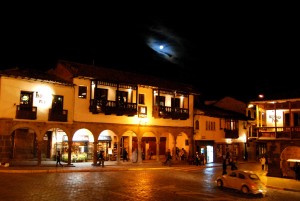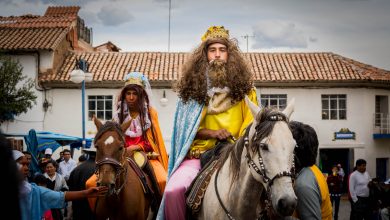Cuzco’s Plaza de Armas’ Energy Draws Visitors and Locals
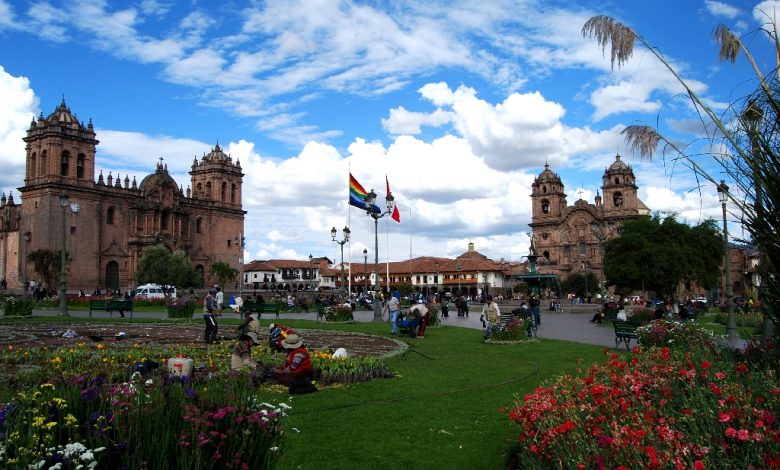
A green and leafy space with flowing water that opens among orange tile roofs, Cuzco’s Plaza de Armas provides an attractive refuge at the same time it is the most important place in the city. If Cuzco is the navel of the earth, the Plaza is where much of its nourishing energy is created as Cuzco’s people and people of many cultures come together.
Called the Haukaypata in Quechua, the Plaza is not only important today but it has a long history of importance as the maintenance of its Quechua name suggests.
It was an Inca ceremonial center. As part of being holy, burials were made at key places as the indigenous Cusqueños connected the above ground with life within the earth. They also connected the highlands with the sea. The entire plaza, which was larger than it is presently, was covered in sand and sea stars. In this way it could become a principal place for ritual.
At times, all the huacas (divine figures) of the Inca Empire were gathered there for ritual. It was a place for dance and song, and for pouring chicha like a river into the earth; just as the Pachamama gave rivers of water to people so they returned to her rivers of chicha–made from their holy white corn.
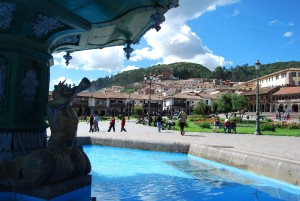
Called variously Huacaypata or Haukaypata, the place of crying (mourning) or the place of warriors, it contrasted with the Kusipata,the place of happiness, on the other side of the Saphi river. Today the river still flows beneath the row of buildings on the side opposite the Cathedral and behind them can still be found the beautiful, but much smaller, Plaza de Regocijo, Spanish for Kusipata.

When the Spanish came the Plaza was remade into a Spanish public place, though still the center of the city. Around its edges elite families acquired the Inca palaces and temples to remake them into Spanish domains. The Church also acquired space there as befits the ceremonial importance of the Church in today’s Cuzco, wedded with indigenous practices and themes. Not only is the Cathedral located at one end of the plaza, to its side is the convent of Santa Catalina and then the proud Jesuit Church called the Company, witness to the power of the religious orders in colonial Cuzco.
Besides at times serving as the weekly market, a role it only fills now with the Santurantikuy market–the “buy yourself saint’s” market, or Christmas market held for one day on December 24th before people gather in their homes to celebrate the coming of the Christ child.
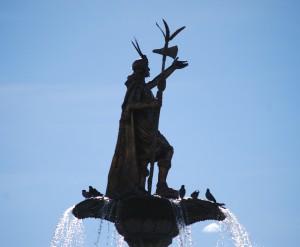
As the key ceremonial space, the plaza did not only see major religious events, such as the processions of the Lord of Temblors, it also witnessed the execution of political figures of great importance, such as the Kuraka (chief) and rebel against the crown, Tupac Amaru. The Spanish tried to draw and quarter him but history says the four horses could not pull him apart, such was his strength so, instead, he was beheaded. He is much loved by today’s Cusqueños as a heroic defender of the people and a monument to him is on the plaza, in front of the University’s building to the side of the Company.
In the center of the plaza stands a nineteenth century fountain, with a year-old fiberglass statue of an Inca on top of it as if rising from the water. Just as that water flows endlessly, so too does a river of people flow through the plaza, rising and falling through out the day. This constant coming and going keeps the plaza alive and important.
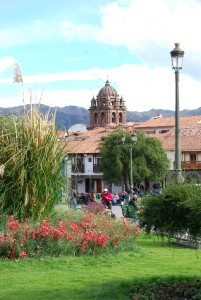
Big events, like all the festivities of Corpus Christi or the lead up to Cuzco’s holy day of celebration, Inti Raymi–the Day of Cuzco, draw enormous crowds. The plaza can become not a river but a sea of people.
But small gatherings also occur regularly. The plaza is a point of gathering for the people of Cuzco. “Where shall we meet? Oh, let’s meet in the center of the Plaza, by the fountain” can be heard constantly among Cuzco’s people.
The Plaza de Armas is a place where older Cusqueños come to sit and rest as the day goes by. But they are not alone. Children come to play with the pigeons, and young people come to see and be seen.
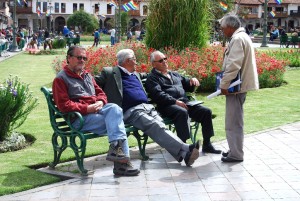
While some children may be running to lift a vast flock of circling pigeons into the air, other children lay out food to see if they can get the pigeons to eat from their hands. Youths meet their friends to talk and share experiences and information, as well as to plan and carry out their activities. Older Cusqueños enjoy the warmth of the bright sun among the beauty of the gardens as, like cats, they sun themselves for warmth, though they also read the newspapers and converse with other people sitting on the plaza’s many green benches. It is easy to strike up a conversation in the plaza.
Not only is the plaza the site of great, public ceremonies, including the weekly parade and raising of the flag of Peru, it is also a main place for social encounters as it has been since colonial times when families would promenade around the plaza.
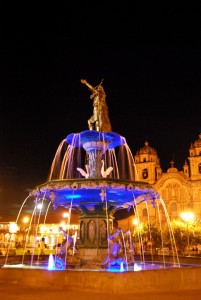
Pathways cross the plaza marking walking spaces among the gardens of flowers as well as of native trees that beautify the square. But it is also set off by Inca walls with colonnades in front. These cover much of the plaza’s four sides and above them sit Moorish-style balconies often with people sitting in them, sipping coffee or beer and looking out at the people in the square and the green hills above them.
Not only are the evident charms of the plaza part of what draws people to it, day and night, it is also gives access to Cuzco’s fine restaurants and much shopping, whether on the plaza or in nearby areas. On it or nearby can also be found many of Cuzco’s discotheques and bars.
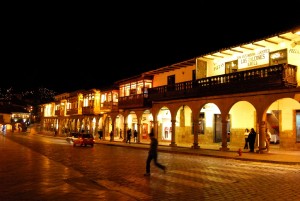
By night the plaza is romantic and attractive with its lights and shadows. It becomes almost a land of magic.
It is not surprising that the municipality will often organize events, such as the light show and concert of this last Wednesday, that fill it with people under a starry sky.
But in any case, day or night, the plaza is Cuzco’s main public place. It is a special and unique place with its history and its importance in today’s Cuzco. It is also unusual in the way it allows so many people from so many different cultures to come together, whether tourists from who knows where, people from the city, or colorfully dressed people from rural Cuzco.
With its flowing water, rituals, gardens, and people, it awaits your visit and invites you to sit and enjoy.
